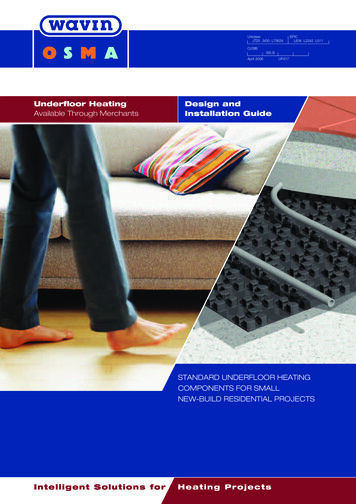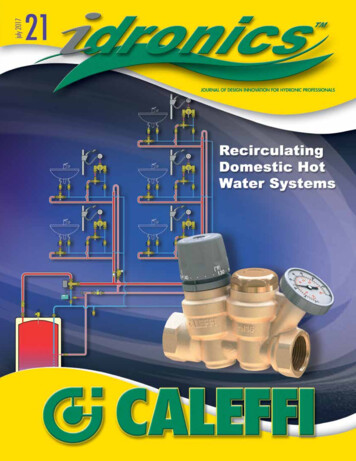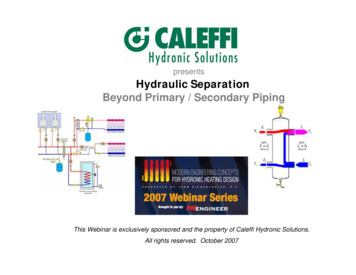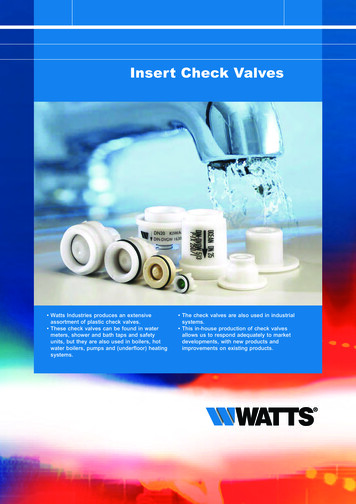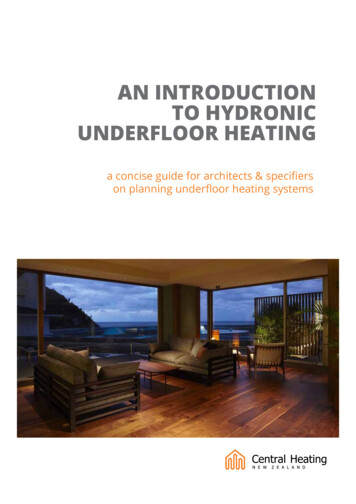
Transcription
AN INTRODUCTIONTO HYDRONICUNDERFLOOR HEATINGa concise guide for architects & specifierson planning underfloor heating systems
IntroductionThis guide is intended as a basic guide to the fundamentals of hydronic underfloor heating to assistspecifiers to incorporate underfloor heating in their design. (Hydronic underfloor heating works bypumping warm water through pipes set inside the floor.)Please contact us for more detailed information.ContentsUnderfloor heating: the ultimate in comfort & design3Underfloor Heating Methods5Can underfloor heating be used with radiators on the same system?6What can I use to heat the system?7Can I heat my house from solaror a wetback system?8Can I only heat part of my house or install a system incrementally?9What are the running costs like for an underfloor heating system?10What level of control is there in a hydronic underfloor heating system?11Design & installation issues to consider when planning underfloor heating12Design & installation process for underfloor heating systems18Our Expertise19
Underfloor heating:the ultimate in comfort & designLuxurious, silent & discreteUnderfloor heating is widely regarded as themost luxurious form of heating. Its radiant heatis evenly distributed throughout the room; wall towall, floor to ceiling.Its heating profile means rooms are warmer atfloor than ceiling level ensures not only warmfeet and a clear unstuffy head, but warmth andcomfort.Hard floor surfaces are warm to the touch – a keyfeature with increased numbers of new housesbeing built with concrete floor surfaces.What’s more the system is totally hidden fromview and takes up no wall space – very importantto many people, especially where large glazed areas mean there is little or no wall space.Water can hold nearly 1,000 times are much heat as the same volume of air so large amounts of heatcan be moved around the house through comparatively small pipes without the need for large ductsand the noise of blown air.Energy efficientHydronic underfloor heating is much more efficient and with much lower running costs than electricunderfloor.The heat can be provided by specially designed air to water or ground source heat pumps, or byboilers fuelled by gas, diesel or wood.3
How does underfloor heating work?The heat source: A boiler or heatpump supplies heat to the systemby heating the water that is pumpedthrough it.21Boileror HeatPrimary pipework carries theheat from the heat source to themanifold(s).Controls : fromPumpvery simple to onein every roomManifolds distribute the heat to theunderfloor pipe loops.Manifold in cabinetPipe loops, with hot water flowingthrough them, heat the floor, typicallyat least 1 loop for every 20m2 ofheated floor area.Controller switches the heat sourceon and off, and directs the heat towhere it is needed to heat the roomsto the desired temperature.Thermostatic valveMore loops(Boilers only)Pipe loops setCan underfloor heating be installed in my home?Heating MethodNew Build?Retro-fit to existinghome?In-slab (Kiwi UF)37European screed33Multitubo Micro-screed33Alloy plate system for timber joist floors33When underfloor is retrofitted the floor level will be raised which means door heights etc will bereduced, unless spreader plates are used under a timber floor.4
Underfloor Heating Methods12mm02kciht341. In-slab, ‘Kiwi’, underfloor heating2. European screed underfloor heatingHeating the construction slab is the most commonlyused form of central heating in New Zealand.Usually around 50mm thick, it has reduced thermal masscompared to in-slab and is totally insulated from the rest ofthe building, and the outside, meaning much lower losses,higher efficiency and faster response to controls.Pipes are laid on polystyrene insulation or attached toreinforcing mesh.Can be used for retrofit if the existing floor is strong enoughand the raised floor level is acceptable. Screed floors arenot part of the structure; they are floor coverings.Advantages: Relatively inexpensive and simple toinstall. Large thermal mass retains heat.Disadvantages: High thermal mass means slowresponse to controls. Because the outside edges ofthe slab are not insulated there can be heat lost to thefootings and re-bar, and to the environment.Advantages: More efficiency and faster response tocontrols. Loses less heat through edge of the slab.Disadvantages:More expensive than basic in-slabunderfloor. Response is still slow compared to thinnerscreeds and radiators.3. Variotherm4. Metal plate timber floor systemVariotherm is a quick-reaction, light-weight system fromEurope that is suitable for both new and existing homes.It is the most efficient of all the warm water underfloorheating methods due to the closely spaced pipes and thinprofile.Alloy plates to spread heat are laid under floor boards ortimber panel floors. The pipes are clipped into the plateswhich conduct the heat away from the pipes. Insulation ispositioned under the plates and pipes. Used extensively inEurope where there are many timber floors supported bejoists or battens.Advantages: It is much thinner than a standard systemwhich reduces thermal mass so it heats up and coolsdown quicker than the other systems. It can be used inrenovations and structures with a low weight requirement.Advantages: Enables underfloor heating for timberfloors without raising the floor level in existing buildingsor building a floor to support a heavy screed in a newbuilding.Disadvantages: More expensive to lay than the basic inslab system.Disadvantages: This system is probably the most labourintensive and therefore more expensive to lay than thebasic in-slab floor. Access under the floor is needed or thefloor deck has to be removed.5
Can underfloor heating be used withradiators on the same system?Incorporating radiators into an underfloor systemRadiators and underfloor can be and are often used inthe same system. Usually with the living areas kitchen andbathrooms, (hard floor areas) in underfloor, and the bedroomswith radiators.This is easy to accomplish with a boiler as it can supply hightemperature water to the radiators, and heat the floor via andthermostatic valve to reduce the temperature of the watergoing into the floor.If a heat pump is used the radiators will have to be sized to runat a lower temperature, or two heat pumps used, one for theunderfloor and a high temperature model for the radiators.Incorporating small areas of underfloor with a radiator systemIf a system is mostly radiators it is possibleto have a small area of underfloorrunning through a return temperaturelimiting valve. This can cover about15m2 per valve.This is a specifically designed thermostaticvalve that allows the floor to be heatedvia higher temperature water but limitshow hot it can get.6
What can I use to heat the system?Runs on your preferred fuel, no matter where you areUnderfloor heating can use heat pumps or boilers for supplying heat. Often the heat source isdetermined by the availability of fuels in the area.Heat pumps work very efficiently and have low running costs at the lower operating temperatures ofunderfloor, typically 40 C, compared to radiators, typically 70 C.High efficiency condensing boilers also run more efficiently at lower operating temperatures.Unless a Baxi gas boiler is used, which has a special underfloor setting, a mixing valve is needed toreduce the temperature of the water going into the floor.Baxi Gas BoilerAttack Log Gasification BoilerFirebird Diesel BoilerDeLonghi Ground Source Heat PumpWoodpecker Wood Pellet BoilerDeLonghi Air Source Heat Pump7
Can I heat my house from solaror a wetback system?Using SolarGiven that many homes now use solar systems to provide their home’s domestic hot water, usingthe free power from the suns rays to heat a home may seem like a good idea. However in practicethis is very difficult to achieve.First, heat demands for a home are much greater than hot water requirements - in fact in wintera home’s hot water requirements may only be 10% of the total heat demand of the home. What’smore, this is at a time when the sun is at its weakest and lower in the sky. as there is far less sun inthe winter – that’s why winter is cold. In the winter months the sun is only over the horizon for onethird of the day meaning the system has to collect enough heat in that time to heat the house for theremaining two thirds of the day.A typical solar hot water system produces only about half an average hot water load in the winter approximately 5kWh a day. Given that a typical winter heat load can be 50kWh to 100kWh a day ormore, a large number of solar collectors will be needed with sufficient heat storage to last throughthe nights and the days with no sun.To make this work you need a very low heat loss house and to accept that you may have to use otherheat sources during times of very cold weather.And, you have to find a use for all the heat generated by the solar collectors in the summer, such asswimming pool heating.Using a wetbackWetbacks only produce 1kW to 2kW of heat which is all that’s needed to heat a hot water cylinder overthe course of a few hours while the log burner is on. This will only provide a little extra backgroundheat; enough for one or two rooms.As a wetback is an uncontrolled heat source adding heating on will also require a header tank toguard against overheating which is a significant extra cost if you don’t already have this.8
Can I only heat part of my house orinstall a system incrementally?Can I only heat part of my house?With central heating, the overall concept is to heat the home as a whole, thus maintaining a constanttemperature throughout the house, but individual parts can be heated separately if required. Insome homes this is has been done with micro-screed or metal plate systems (see page 5), mostly inhomes that have radiator heating in the rest of the home. This is sometimes seen in homes with tiledhallway, conservatory or kitchen floors that require an underfloor heating solution.If in-slab heating is partly installed, some of the heat from the pipes will dissipate through the slabbut it will not effectively heat the rest of the home, merely take the chill off the floor slab. In homeswhere only part in-slab heating is to be installed it may be prudent to install pipes through the wholeslab at time of pour, as these could be blanked off and used at a later stage if required (see below).Can I install the pipes now and the rest of the system later?It is possible to install pipes during construction and put the rest of the system later. In these caseshowever the same amount of planning will be required pre-construction that would be undertakenon a full installation, namely it is still important to have the system designed correctly first heat source position and manifold positions will need to be allowed for and noted accordingly,as this could have a bearing on future construction, eg wall and door placement primary pipework will probably need installation too wiring for any controls may need to be run before wall linings are installed the pipe loops should still be pressure tested9
What are the running costs like for anunderfloor heating system?Running costs are a key issue for clients and one which can be very difficult to answer due to thevariability in types of fuels and prices around New Zealand and individual’s comfort requirements after all, we’re all different when it comes to how warm we like our homes.It is fairly easy to estimate unit running costs for different heat sources but annual totals vary greatlyaccording to the size of house and lifestyle.Running costs for different fuelsBased on 20,000 kWh heat load which could include potable hot water or other heat loads such asswimming pools. Costs calculated January 2012 for Christchurch, NG for AucklandHeat sourceAnnual heating cost ( )Unit heating cost(cents/kWh)Baxi high efficiency gas boiler (NG)1,8019.0Baxi high efficiency gas boiler (LPG)3,48917.5Firebird Enviromax diesel boiler3,00415.0Woodpecker wood pellet boiler2,26111.3Air to water heat pump*1,2506.3Ground Source heat pump*8754.4Electric underfloor*4,37621.9*Assumptions made about electricity pricing. No daily fixed charge is included in costings for single phase supplies as it is assumed this would be paid anyway, evenwithout electrical heating. A prompt payment discount of 10% is applied Cost estimates are for single phase power onlyInstallation CostsTotal installation cost will vary depending on the type of heat source used but the cost of laying pipeloops and primary pipes, and installing manifolds for a heated construction slab system is around 20 per square meter for the in-slab system, including labour. Actual costs depend on the complexityof the system and other factors.3-Phase ElectricityFor a heat pumps with an output greater than 14kW a three phase model would be needed.The cost of connecting three phase power to a site that wouldn’t otherwise have it needs to be takeninto account. The tariff is likely to be commercial with a larger fixed cost element and reduced unitcharge compared to a standard domestic tariff.The connection and running costs will be particular to the site so it is not possible to give generalisedadvice.It is possible to used single phase to three phase converters, or more than one single phase heatpump on site provided the total power (kW) drawn doesn’t exceed the total power available for thesite.10
What level of control is there in ahydronic underfloor heating system?Heating controls allow central heating systems to runtotally automatically with virtually no input from the userother than to change or temporarily override the program.This is a major attraction of central heating as the house isalways warm when you get up in the morning no matterwhat the weather, with minimal input from the users.The basic functionality of the control system is to switchthe heat source on and off, and to direct the heat towhere it is needed by opening and closing valves, and/orswitching pumps on and off.Each system is designed according to the occupant’spersonal preferences. Some people prefer to run thesystem continuously all winter, only controlling thetemperature of the water going into the floor; whilst others have thermostats in each room toprecisely control the temperature according to a time schedule.Multi zone controlIt is possible to create different zones within a house which areautomatically heated to different temperatures at different timesbut can still be overridden manual when a variation to the scheduleis needed.Having separate thermostats and time schedules for each room canmake for a very complex control system; and potentially confusingif the owners haven’t had central heating edroom 4EnsuiteSlab temperature and response rateThe thermal mass of a heated slab or European screed system islarge and so it takes a long time to heat up the floor slab. Withthese systems the slab becomes a heat store.Family/DiningBedroom2Zone 1Zone 2MasterBedroomControllers for high thermal mass systems monitor the actual floorslab temperature to keep it within a certain temperature range to improve response time.Zone 3Zone 4Zone 5When using a heat pump it is often only the temperature of the slab that is controlled by running theheat pump continuously at a fixed setpoint.When the house is heated by the sun and the room temperature rises, the temperature differencebetween the slab and room is reduced, and so the heat transfer becomes minimal. To a large extentunderfloor heating can be self regulating without the need for a room thermostat.11
Design & installation issues to considerwhen planning underfloor heatingManifold placementManifolds are a key part of the system and needto be placed as centrally as possible in the housefor optimal performance. Usually they are at theback of cupboards or in the laundry. Due to thepressure loss in long pipes there is a limit to howlong the pipe in each loop can be and still achievethe necessary flow rate. Generally this is around100m.If there is one manifold at one end of the housepipes needs to be run to the other end of thehouse and back reducing the length of pipe in thearea being heated by that particular loop. Thisalso produces a hot floor, usually in the hallway,where heating is least needed.Underfloor manifolds are not a decorative featureand need to be hidden, however simply puttingthem out in the garage may well result in apoorer performing system. A better result for thecustomer is to find or create space for a manifoldcabinet (see diagram, right)Manifold cabinets: Height 600mm; depth130mm; Length depends on number of loops andwhether a mixing valve is used or not.In this drawing the manifold cabinet (circled) is inset into the wallat the back of the airing cupboard, reducing space taken, up andallowing pipes to leave the manifold in either direction which isoften better than from one side onlyLoop 9ManifoldA centrally placed manifold uses20% less pipe, and 20% less pipelaying labour costs; and two lessloops to plumb in; and there isno hot track so the heat is moreevenly distributed.Using one manifold at the end ofthe house results in a ‘hot track’of concentrated pipes runningdown the passage, providingheat where it is least needed;and the two bedrooms at theother end of the house needingtwo pipe loops in each room.Bad manifold placementLoop 3Loop 1ManifoldGood manifold placement12
Floor coveringsAny floor covering on top of the heatedpart of the floor acts as a barrier to the heatflowing from the floor into the room. Thickerfloor coverings such as carpet can be used,but the heating system has to be run at ahigher temperature to get the required heatoutput, which is less efficient if a heat pumpis used.If the operating temperature has to beraised just for one room, the whole housewill have to run at a higher temperaturewhich increases running costs if a single heatpump is used.Effect of floor coverings on achieving operating temperature(Floor surface 25 C, Air temperature 20 C)Room temperature 20 CHeatHeatConcrete floorCarpet withunderlay25 C25 CSurface temperature35 C35 CWater temperature45 CConcrete slab or screedNB The temperatures in this drawing are chosen to illustrate the conceptA more expensive alternative is to usemultiple heat pumps running at differenttemperatures. This is sometimes used for larger homes; or use supplementary heating in hard toheat rooms.Heat loss from glazed areasIn a new house around 50% ofthe heat loss is through glazingalone. This is because standardaluminium framed double glazingloses heat at nearly 8 times therate of a standard insulated wall.(See chart, right).A highly glazed room will havemuch more heat loss per squaremeter than the average heat lossfor the house. As the heat flowfrom the floor is limited by thesurface temperature it is possibleeven in a new house to design aroom with a heat loss exceedingthe heat that can be delivered byan underfloor system, particularlyif a heat pump is used which limitsoperating temperature.Heat loss per square meter of external surface (W/C/m2)0123456Roof NZBC minimumFloor NZBC minimumWall NZBC minimumUninsulated weather board wallWindow double, low-e, wood or Window Double low-e, curtainsWindow Double low-eWindow Double clear - curtainsWindow Double clearWindow Single clear - curtainsWindow Single clearHeat loss figures (source: BRANZ Insulation Guide)Such rooms often need a supplementary heat source to maintain the design temperature in verycold weather. Alternatively the thickness of floor coverings needs to be minimised or the glazingspecification increased.137
Design & installation issues to considerwhen planning underfloor heating (cont).Timber & heated floorsTo avoid cracking it is recommended that only properlydried timber is used or a timber floor product with an MDFbacking or similar. Despite these issues it is very commonto have timber coverings on heated floors with no problemsat all.It is preferable to glue timber to a concrete slab or screedand not to use foam backing.Wall positioning and fixings to floorslabBefore the floor pipe loops are installed fora basic in-slab system the builder will needto mark out the position of the walls as it isusual to run the pipes to avoid going underwalls so that the pipes are not puncturedby fixings into the floor.In this picture, right, the wall positions aremarked in yellow and the pipe loop in theroom goes in and out of the doorway.A common cause of pipes being puncturedis when wall positions are changed after theslab has been poured and are put over pipe runs. (This only applies to the basic in-slab method).It is often preferable to have the pipes from a manifold radiating out either side of a wall. Thisrequires the cooperation of all involved to make sure that part of the wall is not fixed into the floorslab where the pipes come into the manifold.14
Concrete crack inducement and concrete cuttingIf you are having a polished concrete floor thought needs tobe given to where cuts are made and how this might impacton the pipes in the floor. This won’t be a problem as long asthe heating installer and builder can work together to makesure the heating system isn’t compromised.There are alternative systems to cutting which avoids anyproblems that might occur.Some are crack inducing systems that are laid at the undersideof the slab, such as the product shown in this picture (right).Expansion JointsAn alternative is to use expansion joints such as theones shown right.When these are used it is important the pipes are laidbefore the joint is fixed in place, otherwise laying thepipe underneath will be very difficult.Screed floorsThe mix of the screed needs to be correct to prevent cracking; CHNZ can provide a specification onrequest.Where edge insulation is used to prevent heat leaking out from the heated slab, as used in Europeanscreed and micro screed systems, the insulation will not provide a good fixing around the edge of afloor.For practical reasons it is normal to cover the top of the edge insulation with the skirting board whichis made the same thickness, as in the diagram below.Wine cellarsMany homes these days have a ‘wine cellar’ which is often a small room rather than a real cellar.Designers need to be aware that even if the floor in that room doesn’t have pipes in it, the room willstill be heated by the heat spreading through the concrete slab from heated areas.15
Design & installation issues to considerwhen planning underfloor heating (cont).Thermal BridgingWhen using an existing building elementas a heat emitter, in this case the floor,there is a danger that heat loss to theoutside can be greater than normal dueto thermal bridging. This is caused byhigher conductivity materials such asconcrete running continuously betweenthe inside and outside of the buildingcreating a path for heat to flow out.This mainly happens with pipes inset intothe main floor slab as other methodstend to be thermally isolated from theoutside of the house.1Pipes set in main slabHeat flows from the main slabthrough the concrete to the outside.(Fig 1, above right)To counter this heat loss, BRANZrecommend using a thermal break oftimber between the main slab and theouter foundation. (Fig 2, right)Screed floors (fig 3, below right) go onestep further by having a completelyinsulated surface slab, cutting out heatloss through the slab edge entirely.2Further options for insulating aroundfloor slabs can be found in the BRANZInsulation Guide.SkirtingboardInsulationTop screed fullyinsulated fromsurrounding structure316
The following examples show othersituations where thermal bridgingincreases heat loss, it will still be possibleto heat the house, but more energy willbe used.Concrete DeckIf a concrete deck abuts a heated floorslab there will inevitably be some heatconducted through to the outside.1Tilt slab or concrete block wallsIf the heated floor slab abuts a concreteexterior wall there will be enhanced heattransfer to the outside.2Unheated space below floor slabIf a heated floor slab has an unheatedspace below it, it must be insulated notonly below the slab but around anysupporting beams.Any block wall supporting the heatedslab will also conduct heat away to theoutside.317
Design & installation process forunderfloor heating systemsIN-SLAB HEATINGSCREED FLOOR HEATINGDESIGN STAGE, agreement needed on:DESIGN STAGE, agreement needed on: Manifold and heat source positions Manifold and heat source positions Position of thermostats and floor probes Position of thermostats and floor probes Draining for heat source condensate Draining for condensate Water supply point for system filling Water supply point for system fillingPerimeter foundations are built withpenetrations for pipeworkPrimary pipe work from heat sourceto manifolds is installedTailings poured DPM under-slabinsulation mesh on chairsPipe loops installed – fixed to meshLoops pressure testedBuilder marksout positionsof heat source& manifoldsPerimeter walls are built with penetrationsfor pipeworkPrimary pipe work from heat sourceto manifolds is installedBuilder marks Shingle poured DPM under-slab insulation mesh on chairsout positionsof joinery &wallsWalls & roof erectedInsulation installed under screed pipeLoops fixed to InsulationLoops pressure testedSlab pouredUnderfloor Cabinets and manifolds installedat pre-pipe stageScreed pouredControl wiring and power to heat sourceinstalled at before wall liningsCabinets and manifolds installed atpre-pipe stageSlab poured for heat pump or boiler - ifoutside – and fuel supply if neededControl wiring and power to heat sourceinstalled at wiring stageFINAL FIXHeat source, pumps etc installedControls installedFuel tank installed if neededSlab poured for heat pump or boiler - ifoutside – and fuel supply if neededFINAL FIXHeat source, pumps etc installedControls installedFuel tank installed if neededSystem commissioned & testedSystem hand-over to customer,accompanied by user manualSystem commissioned & testedDesign StageSystem hand-over to customer,accompanied by user manualInstalled by builderInstalled by CHNZ18
Our ExpertiseDesign excellence - the Central Heating New Zealand differenceAt Central Heating New Zealand we believe that good design should be at the heart of any heatingsystem. That’s why each underfloor system design starts with a heat loss calculation; somethingabsolutely essential in ensuring the finished system will heat to the temperature and comfort levelrequired.To ensure that each of our system performs to exacting standards, Central Heating New Zealandemploys qualified heating engineers and uses state of the art Computer Aided Design tools toproduce designs for residential and commercial properties.About Central Heating New ZealandCentral Heating New Zealand is the country’s leading hydronic heating specialist, offering a full rangeof heat pump and boiler radiant systems to the public and to trade customers nationwide.Central Heating New Zealand is certified with the International Ground Sourced Heat PumpAssociation, and has more than 40 geothermal heating systems installed and operated across NewZealand.For more details on this or any of our products contact us on 03 357 1233 or email enquiries@centralheating.co.nz. Alternatively you can find out more about us and our products at centralheating.co.nz or viewing our product pages on productspec.net19
PO Box 31-274, 52 Pilkington Way, Wigram, Christchurch 8042Tel 03 357 1233 Fax 03 343 1236 o.nz
Design & installation process for underfloor heating systems 18 Our Expertise 19 Introduction This guide is intended as a basic guide to the fundamentals of hydronic underfloor heating to assist specifier
